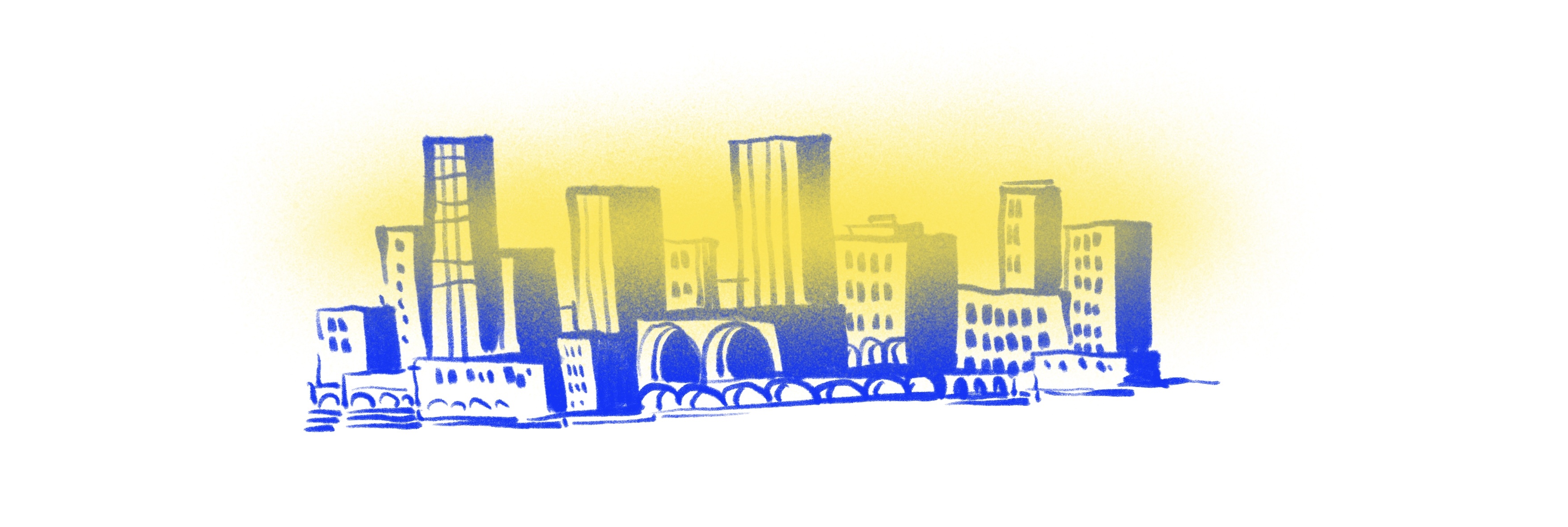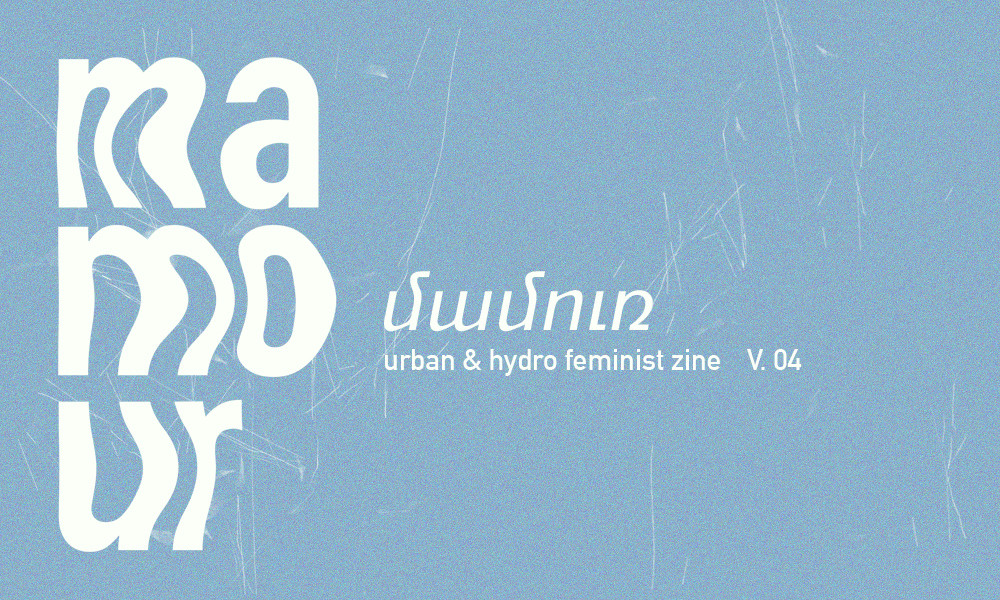When reflecting on Yerevan’s urban environment, attempting to trace the city’s sensory landscape, what often emerges are not images of coexistence and sustainability, but rather the city’s dust, its heat, and thirst. Especially under the scorching summer sun, which grows ever more parched with climate change, the neglect of the environment becomes more sharply revealed, alongside the normalization of profit-driven gentrification and the ongoing degradation of natural landscapes – particularly of the city’s water zones. The privatization, alienation, or commodification of these spaces reflect not only the unsustainable processes of urban planning but also our very attitude towards bodies of water. This alienation of the natural landscape lays bare our positioning toward the environment, the practices and relations we form with it, our gestures of care and neglect.
Beyond the illusion of abundance created by the spray of fountains, one can glimpse our impoverished relationship with water, one that oscillates within the narrow bounds of leisure and consumption. The city’s natural water bodies of its rivers and streams, have vanished from our imagination, our everyday life, and our sensory field, leaving behind only those waters that serve leisure or consumption, and even then, clean and healthy water remains inaccessible to many. (Hetq, 2025)
This thirst of the city, the scarcity and unsustainable use of water, its pollution and unequal distribution, seem to turn water into an instrument that deepens injustice. Yet through the lens of hydrofeminism, these bodies are vital sources. They are addressees of care, but also giving back care in turn, becoming nourishing flows and relations of reciprocity, rare spaces of mutual tending. It is that relationship which binds together all waters – from the ocean to the glass upon a table, from the flowing river to the springs and clouds, from the steam rising out of a teapot to the gulp of water returning to the body: water that runs through our bodies, reaches the ocean and makes us – ourselves watery bodies –particles in an endless cycle.
Has this interrelation been forgotten?
Mamour. Urban and hydro feminist zine’s fourth article seeks to recall this relation and remind us that water flows not only through pipes and reservoirs but also through our bodies, between our bodies, and beyond them. Reflecting on Yerevan’s water zones, this issue aims not only to bring to surface the current problems and challenges of spatial planning but also to highlight the unique expressions of care toward water bodies, and the struggles against environmental injustice, amplifying the voices of those who continue to speak when those responsible remain silent, to warn when developers dig, and to remind when the city’s dry concrete makes us forget the possibility of alternative space.

What might our interrelation with water be like?
To witness its untamed turbulence and endless flow, to listen to its meditative sound, to feel the coolness and freshness it brings, to converse with water, to submerge and immerse memories within it, to surrender wounds and unwanted dreams, fears and anxieties to “the infinite water in which everything is retained, and where all times mingle together.” (MacLeod, 2013). The presence of these sensory and embodied practices of relation directly reflects the hydro-poetics of our space –its intensity and/or its absence.
One of our primary and essential modes of relating to water bodies is through their role in urban spaces and settlements, as points of departure and sources of place. Yerevan, like many other cities around the world, was shaped and came into being from water bodies – nourished and constructed by them. In Yerevan, a city of dust and heat, of sunlight and pink tuff stone, the streams, canals, and rivers have carried vital significance. Yet in this city, formed between two rivers; the Hrazdan and the Getar, water today seems to have vanished, pushed out of the urban image and daily life.
These rivers that have disappeared from the city’s daily life, are first and foremost flows of communication, linking cities and villages, gorges and mountains, weaving together spaces and times while bearing a peculiar vulnerability. The essence of the river as an endless flow, carrying away and departing, makes it a space without a fixed place, impossible to subject or contain, as if always ready to absorb and remove anything from us. If seas and oceans ultimately cast out, throwing up ashore what has accumulated in their depths, the river instead accepts and carries everything away without refusal – becoming a perfect refuge for traumas and memories.
Such fluid spaces seem more vulnerable to pollution, to waste, to gentrification. It is as though Yerevan’s rivers have succumbed to this vulnerability, becoming flows of neglect and contamination, estranged from the fabric of the city. They seem to belong to another spatio-temporal Yerevan, reflecting the city’s difficult past and its transformations.

When peeling away the Soviet and post-Soviet layers of Yerevan, one can discern a city that was originally shaped by the flow of the Hrazdan River. Soviet urban planning, by reconfiguring this fluid axis of the city, imposed a new hierarchical order, one in which the natural landscape was no longer the central part of the city, but rather the representative structures of power. In post-Soviet Yerevan, the expulsion of the Hrazdan gorge and river from urban life only hardened, with the rise of concrete barriers and the sprawl of unfinished construction sites, which have transformed the river into a flowing border. While our relationship to it reduced to crossing it as an obstacle between the city’s neighborhoods.
This space that is cast into the shadows has inevitably become a site of pollution. Along the river, public dining and entertainment venues have multiplied, pouring unchecked waste directly into the water and intensively polluting it with sewage. As well as, according to a 2023 study by the “Hydro-meteorology and Monitoring Center,” the quality of the river water significantly deteriorates after passing through Yerevan, reaching the lowest levels on the five-tier scale for surface water assessment – the 4th and 5th classes (“insufficient” and “poor” quality).
Amid this level of pollution, there is only one wastewater treatment plant planned for the river, which in practice performs merely mechanical cleaning – removing large debris without ensuring any deeper purification. In 2022 alone, about 94% of Yerevan’s wastewater was discharged directly into water environments without undergoing any treatment (Hetq, 2024). Swimming in the river is officially discouraged, though a few individuals continue their active engagement with the water – swimming, exercising nearby, fishing, gathering fruit from riverside trees, or simply spending their leisure time by the river.
The crisis of the Hrazdan River is not only a matter of spatial planning within Yerevan; its impacts extend far beyond the city’s limits. The river’s flow carries waste and harmful substances into the Ararat plain, into cultivated lands and the habitats of countless animals, disrupting ecosystems and leading to environmental disasters. One such instance was the ecological crisis of 2019, when storks in several villages of the Ararat plain were found covered in oily substances. According to scientist Lyuba Balyan, similar pollution was observed in multiple villages, affecting up to 70% of the local stork population. Young storks, including chicks, wandered the streets unable to feed properly. Balyan and her colleagues linked the contamination to improperly managed food industry waste being dumped into the Hrazdan River. This, in turn, harmed the storks for whom the river was a vital feeding ground (Econews.am, 2019). Residents have also repeatedly reported large numbers of dead fish surfacing in the river. (Ecolur, 2019)
Beyond ecological challenges, the Hrazdan River and gorge are also undergoing degradation as cultural and social spaces for the city and its residents. In public perception, the Hrazdan gorge is sometimes seen as a shadowy and unsafe place, where presence and interaction face numerous physical and mental barriers. In this respect, the efforts of the “Urbanista” media initiative are significant: they aim to reimagine the Hrazdan gorge as Yerevan’s green artery, an active recreational zone, and a shared public space.

As the Hrazdan River continues its flow, resisting gentrification and degradation, the Getar River has almost entirely lost the possibility of resistance, and even of being considered a river, colliding with a mode of spatial planning in which streams and water networks, as untamed flows, uncontainable and ungovernable bodies, have simply been erased and rejected by the city. (Amiryan, 2023)
The Soviet-era discourse that cast the Getar as “harmful” and “useless” ultimately led first to the river’s embankment, and later, in the post-Soviet city, to its closure. Decades later, exploiting the danger of flooding, in 2008 the Getar was forced underground, becoming an “easy” solution that avoided the question of restoring and caring for the river. Many residents of Yerevan are not even aware that beneath the layers of concrete and asphalt, the river of Getar still flows through the very center of the city. It receives care only in a few neighborhoods with open banks, from those who live alongside it and who remember the river as clean and free, untouched by the pollution of a gentrifying city.
Beyond such community-based efforts of preservation, environmentalists and urbanists have for years voiced their concerns and protests. Environmentalist Karine Danielyan fought for decades to protect the Getar, constantly warning of the consequences of covering the river and reminding of its importance, vitality, and ecological role. Her message was clear: Yerevan cannot survive without Getar, and the river’s closure would inevitably bring floods and ecological catastrophe, a reality already visible in Yerevan’s streets, with floods recurring again and again: “...now, when the rains come, a river flows alongside the Getar. The water seeks its lawful place and cannot find it.” (Danielyan, 2018)
Beyond ecological concerns, as in the case of the Hrazdan, the Getar has also been stripped of its cultural and social significance. A rare attempt to restore this meaning is the interdisciplinary research project “Getar: The Memory of the River.” (2023) This initiative addresses the closure of the river through the lenses of memory, environmental studies, architecture and urbanism, literature, and anthropology. By drawing on community memory and oral histories, it cracks open the authoritative discourse that has persistently denied the Getar its identity as a river.
Another call for the return and reimagining of the Getar was the 2024 eco-performance action “Open Getar River!,” initiated by visual artist Anna-Lea Kopperi and the Alternative Youth Center. The participants of the performance traced the river’s visible and hidden flows, momentarily surfacing the river, transforming it into a shared space of ecological awareness and collective responsibility. (Citizen’s Voice, 2024)

In this altered landscape of nature, it becomes urgent to reimagine water bodies – to liberate them from the rationalist discourse of the colonial past and from the consumerist gaze of the present. Rejecting the framing of water as merely a “resource,” it becomes crucial to uncover the layered identities of water bodies. Feminist theories situates this restoration of reciprocal care within the concept of rematriation – a notion which, set against the idea of repatriation (the return to a “fatherland” bounded by the discourses and borders of power), suggests a different logic, one that cuts across the administrative, state, and other “unnatural” boundaries that fracture landscapes. It reminds us that natural landscapes and water bodies are infinitely interconnected spaces that cannot be divided or subjected. Within the feminist ethics of care, this reciprocity also carries the dimension of care-receiving – the final turn of the cycle that holds and sustains all relations, reminding us to attend to how bodies, including water bodies, respond to care. (Tronto & Fisher, 1990)
The philosophy of rematriation emphasizes reciprocal care and an ethics of care and recognition of the interdependence with all water bodies. In the context of water, rematriation is not limited to cleaning rivers or “returning them to nature”; it includes restoring our relation to water itself – “thinking with water,” caring for it, and recognizing that we are deeply entwined with these systems. This transforms our everyday practices – interweaving ecological, eco-cultural, and social perspectives, creating a ground where care flows and returns: people care for rivers, and rivers, in turn, shape the quality of human life, establishing a circulation of care.
The rematriation of Yerevan – the vision of returning its waters –is not merely ecological restoration; it is a reimagining of the city’s natural landscape as cultural and social space, where memory, care, and community flow as freely as water.
To return water to Yerevan is to return the city its possibility of resistance.
To return water to Yerevan is to return Yerevan itself – freeing it from the colonial frameworks that have shaped, and continue to shape, our spaces, our environments, and our bodies.
To return water to Yerevan is to return to a city no longer suppressed, silenced, or commodified, but reimagined as a space of justice, reciprocity, and care.
Sources
Ավետիսյան, Ֆ., Սարկիսովա, Ա. (2025) Էրեբունցիները ծորակից ջուր չեն խմում. այն վատ հոտ, համ, հաճախ նաև տարօրինակ գույն ունի. Հետք. https://hetq.am/hy/article/176075
Chen, C., MacLeod, J., & Neimanis, A. (2013). Thinking with Water. In McGill-Queen’s University Press eBooks. https://doi.org/10.1515/9780773589339
Հիդրոօդերևութաբանության և մոնիթորինգի կենտրոն. (2023). Հրազդան գետի ջրում ամոնիում իոնի պարունակությունը ապրիլին. https://armmonitoring.am/post/988
Գրիգորյան, Ռ., (2024) Ո՞վ է զբաղվում «Աերացիա» մաքրման նորակառույց կայանի շահագործմամբ․ արդյունքներ առայժմ չկան. Հետք. https://hetq.am/hy/article/165813
Econews.am. (2019) 100-ավոր արագիլներ դատապարտված են անկման Հրազդան գետ լցված նյութերի պատճառով (ֆոտո). https://econews.am/?p=10937&l=am
ԷկոԼուր (2019) Սատկած ձկներ Հրազդան գետում, տեսուչները պարզում են ձկների անկման պատճառները. Ecolur.am https://www.ecolur.org/hy/news/sos/11063/
Մալումյան, Ա., Խաչատրյան, Ա. (2019) ՀՐԱԶԴԱՆԻ ԿԻՐՃԸ՝ ՆՈՐ ՀԱՆՐԱՅԻՆ ՏԱՐԱԾՔ ԵՐԵՒԱՆՈՒՄ. Ուրբանիստա. https://urbanista.am/hrazdan-gorge
Հարությունյան, Տ. Դանիելյան, Կ. (2018) Երևանը պատրաստ չէ դիմակայել անձրևներին». Կարինե Դանիելյան. Aravot.am. https://www.aravot.am/2018/11/12/992785
Ամիրյան, Տ. Գալստյան, Հ. (2023) Գետառ. գետի հիշողություն. CSN Lab. Երևան https://csnlab.net/am/article/getar_book
Citizen's Voice Media (2024) "Open the Getar River": Walking action with environmental artist Anna-Lea Kopperi. https://cvmedia.am/page2-4574-&lung=en-88
Tronto, J. C., & Fisher, B. (1990). Toward a feminist theory of caring. In Circles of care (pp. 36-54). Suny Press.

